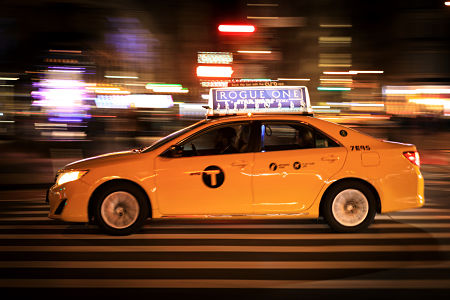For decades, taxi medallions in America’s largest cities were some of the best investments around.
 Governments capped the number of medallions issued so if someone wanted to drive a cab they had to have a medallion or lease one from the people who had them.
Governments capped the number of medallions issued so if someone wanted to drive a cab they had to have a medallion or lease one from the people who had them.
Then about five years ago Uber splashed on the scene followed by Lyft, Asia’s Didi Chuxing and a host of others. Ride hail crashed the party and the taxi industry started taking it on the chin.
Last year, the city of Chicago announced an auction of 50 new medallions to raise revenue and set the minimum bid at $360,000, what the existing owners considered the market price.
Apparently, no one showed up. The city never announced any new medallion sales and eight months later said the process was “not yet final.”
“At that point,” says Michael Shakman, a Chicago attorney who is suing the city on behalf of investors and companies who own medallions, “it became apparent to everybody — if it hadn’t been apparent before — that something fundamental had changed in the marketplace.”
“As soon as you do away with limited access, over a period of years, the taxi industry will wither away and die,” says Shakman. “You will be left with whatever the free market generates by way of transportation.”
The taxi industry warns that without medallions, cities will lose their control over an essential public service. Uber counters that medallions have created a cartel that operates for its own benefit — and not in the best interests of the public.
“If we cared all that much about what the consumer experience was, is this the system we would have built? Absolutely not,” says Corey ¬Owens, Uber’s head of global public policy. “People talk about Uber as this revolutionary thing. The technology is very sophisticated. It’s cool. But I think what’s truly disruptive about Uber has to do with economic incentives.”
“The medallion owners seem to believe they are entitled to indefinite appreciation of their asset,” Owens says. “The taxi medallion in the U.S. was the best investment you could have made in the last 30 years. Will it go up forever? No. And if they expected that it would, that was their mistake.”
In New York, medallions peaked at a value of $1.3 million as recent as 2014. Now those same medallions can be had for as low as $150K.
In Boston, medallions go for $700,000; in Philadelphia, $400,000; in Miami, $300,000. Where medallions exist, they have outperformed even the Standard & Poor’s 500-stock index. In Chicago, their value doubled since 2009. But since ride hail emerged in the marketplace, those numbers have been moving in the other direction.
Three credit unions that specialize in financing the purchase of medallions are facing bankruptcy; a growing number of medallion owners now owe more on their loans than the medallions are worth.
In New York City, the number of tin, hood-installed medallions, now at 13,587, is fixed by the city’s Taxi and Limousine Commission, which also protects yellow cabs’ two most precious rights: picking up people hailing on the street and picking up passengers from the dedicated lines at LaGuardia and J.F.K. Airports.
Ride hail companies like Lyft say they would not have a market if the taxi industry was truly serving its customers.
“If in fact the taxis were doing what they were required to do with providing universal service, why would Uber, Lyft and Sidecar exist?” says David Estrada, Lyft’s vice president of government relations. “The only reason we exist is because current regulations and the current system is not serving people.”
Uber and Lyft say they want to strip away regulation that’s primarily anti-competitive and instead focus regulation on the things that matter, like safety and universal service. Medallions were created to do just that; they were a means, not the end, according to the companies.
